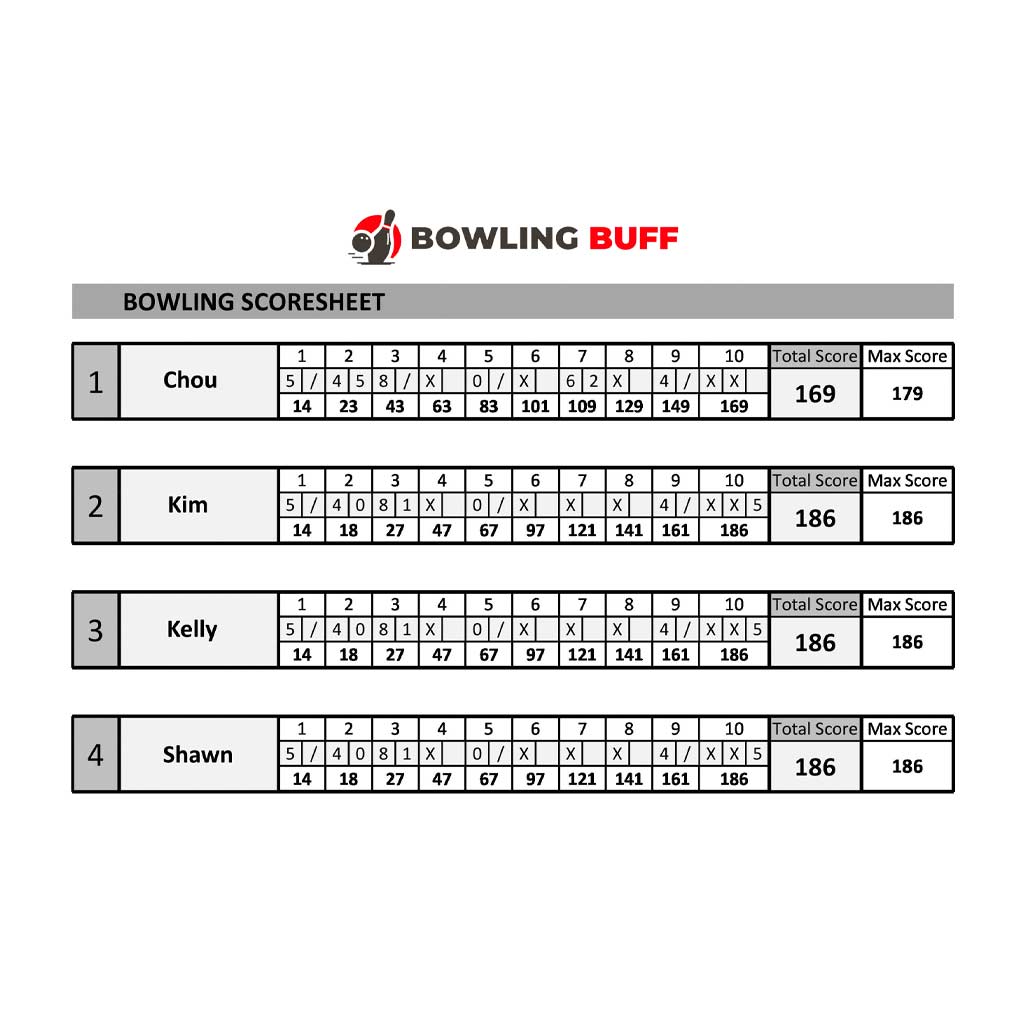Bowling is a sport beloved by many for its simple rules yet immense fun and competitive nature. However, amidst the strikes and spares, one aspect that can’t be ignored is dutifully keeping score.
Tracking your score provides tangible numbers and trends you can use to set goals, chart progress, compete, and enhance skills. Without proper scoring, much of bowling’s satisfaction and thrill is lost.
That’s why understanding bowling score sheets and using an efficient scoring system is essential. In this comprehensive guide, we’ll cover everything you need to know about recording your bowling scores correctly. You’ll learn step-by-step how to fill out traditional score sheets plus discover better resources to make scoring easier.
So grab your ball and shoes! This guide will ensure you’ll never have to wonder what your bowling score is or should be ever again.
Step-by-Step Guide to Filling Out a Bowling Score Sheet
While computers and mobile apps have certainly simplified bowling record keeping nowadays, doing it old school with pencil and paper score sheets is still a classic practice. Knowing how to mark frames properly prevents confusion, disputes, and accidental score inflation when numbers don’t add up!
The score sheet layout seems basic on the surface but can get tricky when splits and strikes make tallying scores convoluted. Let’s break it down frame-by-frame:
Frames
The foundation of any bowling score sheet is the 10-frame layout. Each frame box has room for two rolls notated, except for the 10th frame which allows bonuses. Frame numbers are listed on the left while total score boxes run down the right side.
Squares for Each Roll Inside each main frame sit two squares, one for your first roll knockdown and one for your second roll:
- Write the number of pins knocked down
- Draw a diagonal line for missed rolls
- Circle total pins if a strike
So if you knocked over 7 pins on your first roll and then 3 more on your second, you’d write “7” and “3” in Frame 1’s boxes accordingly.
Running Score
On the right side of score sheets are vertical boxes for calculating running totals after each frame. Write your score as you reach the end of every frame. Pro tip: Add each frame twice to prevent errors!
Pay Attention to Strikes and Splits
Things get slightly complicated when strikes and tricky “splits” occur:
- Strikes – Draw a large circular line around the entire box for frames where you get a strike. Count strikes as 10 plus pinfall on next two rolls.
- Splits – Make circles half full or draw diagonally across one roll’s square if you left a stubborn portion of pins known as a “split.” This signals only part was hit.
Properly Filled Out Bowling Score Sheet Example:

This covers the step-by-step essentials of filling out bowling score sheets accurately as you bowl. Now let’s examine best practices for tallying final scores.
Calculating Your Bowling Score Correctly
Adding up bowling scores demands precision as scratches can significantly alter totals, especially in competitive play. Here’s a reliable multi-step system to determine true totals:
Score After Each Frame
Run a tally in the designated total score boxes down the sheet’s right side after every single frame. This prevents scrambling to decipher messy corrections and unfinished math calculations at the very end.
Pay Attention to Strike Frames
When scoring strikes, calculate the next two ball rolls and add them to 10 pins for the strike itself. Circle and wait two frames to finalize the totals. Example:
Strike box (Frame 1): Circle 10 pins
Frame 2 rolls = 5 pins + 4 pins = 9 pins
Add to strike:
10 (strike) + 5 (next roll) + 4 (next roll) = 19 total pins
Handle Spares Carefully
For spare frames, tally the real knockdown then add the next ball for a full 10 points. So spare in Frame 3 of 7 pins, plus 4 pins for the next throw means 7 + 4 = 11 total points.
Mind the Special Tenth Frame
The 10th frame offers a chance for three balls if you strike or spare. This lets you score over the typical maximum of 200 points. Be sure to use its extra boxes and pay attention here. don’t forget its bonuses amidst excitement!
See, precisely calculating bowling scores takes attentiveness as strikes and spares make totals dependent across multiple frames. But this process ensures you get the real score you deserve!
Conclusion
Mastering scorekeeping represents an underappreciated but crucial element that puts bowling’s fun over the top. Understanding how to fully utilize score sheets while tabulating frames accurately lets you compete seriously, chart improvement, and earn every point you make knocking over pins.
Meanwhile, tapping custom printable templates and innovative mobile apps makes recording scores easier plus adds beneficial stats analysis. We hope our comprehensive guide ultimately helps you track scores seamlessly so you can just enjoy bowling games to the max!
Now that you’re equipped with specialized knowledge for recording strikes and spares, go out and rack up big points on the lanes. And may your names fill the highest score placards for years to come!
Frequently Asked Questions
How do you count scores in bowling?
You count scores in bowling by adding up the number of pins knocked down per roll. 10 pins is the max per roll. Strike = 10 plus next two rolls. Spare = 10 plus the next roll. Score each frame before moving to the next.
How do you fill out a bowling score sheet?
To fill out a bowling sheet, write pins knocked down for each roll in the frame boxes. Draw lines for missed rolls. Circle all 10 pins for strikes. Tally running score down the right side total column after every frame to track scores.
How much is 4 strikes in a row?
4 strikes in a row is 80 points. Each strike earns the bowler 10 points plus the next two rolls. So 4 consecutive strikes means 4×10 for the strikes (40), plus the two rolls after each (10 points per strike x 4 = 40 additional points).
How many points do you get for a strike?
You get 10 points for a strike itself plus the points from your next two rolls. So the minimum for a strike is 10 points while the maximum possible is 30 points if you roll two more strikes.
How many points is 3 strikes in a row?
3 strikes in a row earn a bowler a minimum of 60 points. The maximum possible is 90 points. Each strike is worth 10 points. So 3 strikes is 30 points already. Add the two rolls after each strike for another potential 10 points per strike.
How many points is 2 strikes in a row?
2 strikes in a row earn a minimum of 30 points. 20 for the strikes, plus the two rolls following each worth up to 10 points. The maximum points possible with two consecutive strikes is 50 points.
How do you score bowling for dummies?
Scoring bowling for beginners is easy: Simply add up the pins you knock down each roll per frame. Strikes = 10 plus your next two rolls. Spares = 10 plus your first roll after it. Use score sheets and tally each frame. Apps automatically track scores too.
What is the number 1 pin in bowling called?
The number 1 bowling pin, located front and center, is called the head pin. It’s the “leader of the pack”. Knocking over the headpin often creates a powerful domino effect on surrounding pins. But leaving it standing makes picking up spares very challenging.
What is a perfect score in bowling called?
A perfect score in bowling is called a 300 game or bowling a “300”. That means a player bowled nothing but strikes in all 10 frames for a total score of 300 points, the maximum possible.





